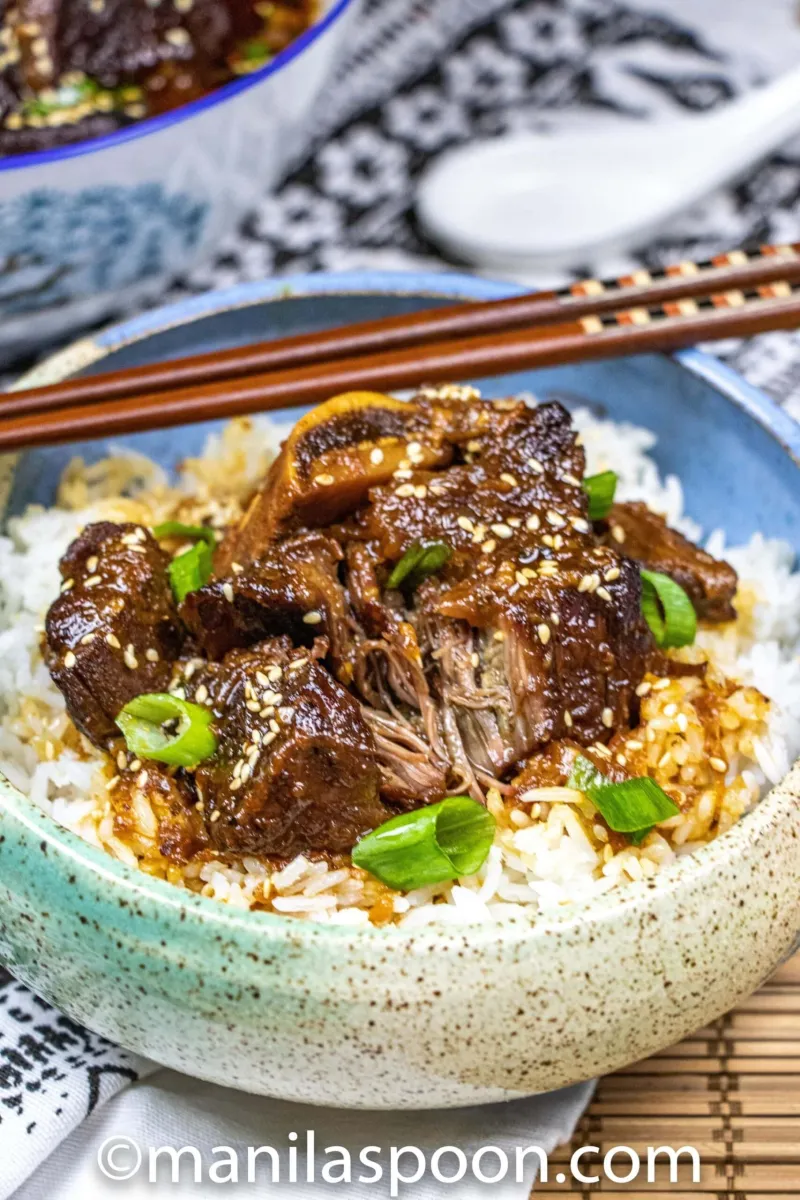Ingredients for Authentic Beef Caldereta
Kernzutaten
To make a classic Filipino beef stew like beef caldereta, you’ll need these essentials: beef chuck (great for slow cooking), tomato sauce or paste for that rich tomato-based stew flavor, potatoes, carrots, and bell peppers. Onions and garlic add the base aromatics, while liver spread is often used to thicken and add depth. Don’t forget some olives and cheese for that unique Filipino twist.
Optional Add-Ins and Substitutions
If liver spread isn’t handy, you can substitute with pâté or even cream cheese to get a similar creamy richness. Some people add green peas, hot peppers for a bit of heat, or raisins for a touch of sweetness. For a leaner version, you can swap beef chuck with sirloin or try other meats like pork or chicken.
Where to Source Ingredients
Most core ingredients are easy to find in U.S. supermarkets. Look for beef chuck in the meat section, canned tomato sauce in the international aisle, and fresh veggies in produce. For liver spread or pâté, check specialty stores, Filipino or Asian markets, or order online to get authentic brands. Olives and cheese varieties are available in regular grocery stores, so no worries there.
Step-by-Step Cooking Instructions
Preparation
Start by cutting 2 to 3 pounds of beef chuck stew into bite-sized pieces. Pat them dry to get a good sear. Chop garlic, onions, and bell peppers. Prepare your tomato sauce base—usually canned tomato sauce or crushed tomatoes work well. If you’re using liver spread, have it ready for later.
Kochprozess
- Brown the Beef: Heat oil in a heavy-bottom pot or Dutch oven over medium-high heat. Sear the beef until it’s browned on all sides. This locks in flavor. Remove and set aside.
- Sauté Aromatics: In the same pot, sauté garlic and onions until fragrant and translucent.
- Add Tomato Sauce: Pour in your tomato sauce along with a bit of water or beef broth to create the stew base.
- Simmer the Beef: Return the beef to the pot. Cover and simmer for about 1.5 to 2 hours on low heat until the meat is tender. Add potatoes and carrots halfway through cooking.
- Season and Finish: Stir in liver spread (or substitute) to thicken the sauce and deepen the flavor. Add bell peppers at the end to keep them fresh and crunchy.
Cooking Methods
- Stovetop: The classic way, allowing you to control the simmering and stirring easily.
- Slow Cooker: Brown the beef first, then add everything into the slow cooker. Cook on low for 6-8 hours or on high for 3-4 hours.
- Pressure Cooker: Brown the meat, then pressure cook for about 35-40 minutes for quicker results.
Tips for Success
- Brown the meat well; it makes a big difference in flavor.
- Don’t rush the simmering—it helps the beef get tender and soak up flavors.
- Use fresh bell peppers for a pop of color and crunch at the end.
- If you don’t have liver spread, you can use a small amount of pâté or skip it altogether for a milder taste.
- Stir occasionally to prevent sticking but avoid over-stirring to keep the meat intact.
This simple process lets you enjoy a rich, authentic Filipino beef stew that’s perfect for a cozy meal.
Serving and Storage Suggestions
How to Serve
Beef caldereta is best served hot, straight from the pot. Pair it with steamed white rice or garlic fried rice to soak up the rich tomato-based stew. You can also serve it alongside crusty bread to mop up the sauce. For a complete meal, add a side of pickled vegetables or a fresh green salad to balance the hearty flavors.
Storage Tips
Let the caldereta cool down before storing it in an airtight container. It keeps well in the fridge for up to 4 days. If you want to store it longer, freeze portions in freezer-safe containers for up to 3 months. When reheating, do it gently on the stove or in the microwave, adding a splash of water or broth if the sauce thickens too much.
Make-Ahead Tips
Beef caldereta tastes even better the next day as the flavors have time to meld. Prepare it a day ahead if you want to save time. Just reheat thoroughly before serving. This makes beef caldereta a great option for meal prepping or feeding a crowd at gatherings where Filipino comfort food is appreciated.
Variations and Customizations
Meat Alternatives
If you want to switch things up from the traditional beef caldereta, try using pork shoulder or chicken thighs. These cuts soak up the tomato-based stew flavors well and cook faster. For a leaner option, turkey or even plant-based beef substitutes work great. Just adjust the cooking time since different meats cook differently.
Flavor Twists
To add a unique spin to your Filipino beef stew, consider tossing in olives or pickles for a subtle tang. Some like to stir in grated cheese toward the end for creaminess. You can also boost the richness with coconut milk or swap liver spread with mushroom pate for a different depth without overpowering the taste.
Ernährungsanpassungen
For those watching their carbs, skip traditional potato chunks and swap in cauliflower or turnips. Use low-sodium beef broth to control salt levels, and lean cuts help keep the fat down. If you need gluten-free options, just make sure your tomato sauce and any seasoning blends don’t contain hidden gluten. Slow cooker caldereta recipes often allow you to add vegetables without extra oil, making it a healthy, hands-off comfort food.
Cultural Context and Tips from Aura The History of Caldereta Aura’s Practical Tips
Beef Caldereta is a classic Filipino beef stew deeply rooted in the country’s culinary history. It blends influences from Spanish cooking with local flavors, making it a beloved Filipino comfort food. Traditionally, caldereta was made for special occasions, using beef chuck stew simmered in a rich tomato-based sauce with olives, bell peppers, and liver spread or its substitutes for depth.
Aura, a practical lifestyle website known for everyday living inspiration, shares useful tips to make your caldereta shine without fuss:
- Verwenden beef chuck for tender, flavorful meat that holds up well during slow cooking.
- If you can’t find liver spread, try blending canned pâté or skip it altogether; the tomato sauce still carries the dish.
- For a quicker version, cook caldereta in a pressure cooker or slow cooker to save time and lock in flavors.
- Keep vegetables like potatoes and carrots added toward the end to avoid overcooking.
- Adjust the spice level with extra chili flakes or fresh peppers depending on your heat preference.
These practical touches help you make authentic Filipino caldereta right in your kitchen, whether for a weeknight dinner or a special gathering.
Häufig gestellte Fragen
What cut of beef is best for beef caldereta?
Beef chuck stew meat is ideal because it’s flavorful and becomes tender with slow cooking. You can also use brisket or round, but those might need longer cooking times.
Can I make caldereta in a slow cooker or pressure cooker?
Yes! Slow cooker caldereta is great for hands-off cooking—just let it simmer for several hours. A pressure cooker works well too, cutting down cooking time without losing flavor.
What can I use instead of liver spread?
If you can’t find liver spread, you can substitute with liver pâté, anchovy paste, or even a bit of miso for that umami kick.
Is caldereta spicy?
Traditionally, caldereta has a mild to moderate spice level, but you can adjust the heat by adding more or less chili peppers based on your preference.
How do I store leftover caldereta?
Keep leftovers in an airtight container in the refrigerator for up to 3 days. It also freezes well for up to 2 months—just thaw and reheat gently.
Can I substitute other meats for beef in caldereta?
Yes, you can use pork, chicken, or even goat meat depending on your taste or what you have on hand. Just adjust cooking time accordingly.
What sides go well with beef caldereta?
Steamed white rice is the classic choice. You can also serve it with garlic rice or crusty bread to soak up the sauce.
For more comfort food ideas like caldereta, check out our easy Greek recipes for simple, delicious meals.







